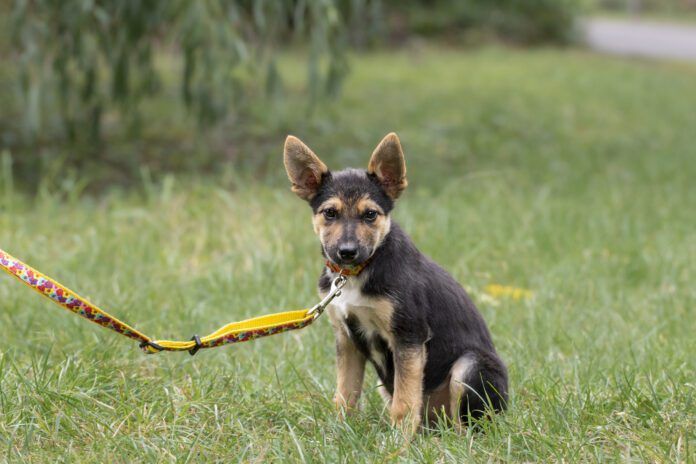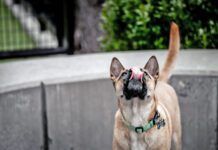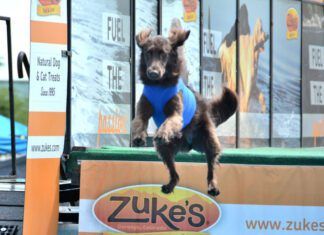Dogs are naturally social beings, but that doesn’t mean every puppy leaves the litter with social skills or that trauma can’t derail an adult dog who previously socialized with other dogs, people, and other animals.
What Is Dog Socialization?
Socialization is the process of preparing a dog to enjoy interactions and be comfortable with other animals, people, places, and activities, according to the American Veterinary Medical Association (AVMA).
Research shows that, while dogs of any age can be socialized, ideally, socialization should begin between 3 and 14 weeks of age. During that period in a pup’s life, they are deeply impacted by their experiences, according to research.
Having a well-socialized dog means more than just a friendly pup. The Oregon Veterinary Medical Association (OVMA) advises that, if dogs do not become socialized, they may become anxious, fearful, and antisocial with people and other animals.
And that’s a major concern. Behavior problems are a major reason so many pets are brought to shelters. The frustrated owners just don’t know how to handle a poorly socialized dog.
Signs of a Poorly Socialized Dog
While some excitement is normal, poorly socialized dogs may exhibit over-excitement or hyperactivity in social situations, leading to inappropriate behaviors like jumping or nipping.
Poorly socialized dogs often show distress when faced with new stimuli. Their reactions can vary in intensity, but they usually stem from fear or anxiety.
If not properly socialized, your dog may exhibit behaviors such as aggression toward strangers and other dogs. Signs of a poorly socialized dog include, but are not limited to:
- Anxiety/fear
- Cowering
- Difficulty grooming
- Excessive barking
- Fear of noise
- Growling
- Reactivity on walks
- Separation anxiety
- Snapping
If you suspect your dog may be poorly socialized, it’s crucial to consult with a certified dog trainer or veterinary behaviorist for guidance.
How and When to Socialize Your Puppy
Focus on socializing your puppy the moment you bring her home. Try to patiently and gradually expose her to a variety of sights, sounds, and experiences. You can go on walks in different places, take a puppy training class, take your puppy with you to stores like Home Depot that generally allow dogs, maybe schedule play dates with a friend who has either a gentle older dog or a puppy close to your dog’s age and size. Throughout all this, always be patient with your puppy.
Never force your puppy to deal with something; if the puppy is fearful, move farther away from the scary thing and distract the puppy with treats. You can also simply leave and try on another day(s), with lots of extra yummy treats.
The Animal Humane Society suggests:
- Handle your puppy daily, including gentle petting, holding, and examining paws and ears.
- Gradually introduce your puppy to a variety of everyday sounds (e.g., traffic, appliances, children).
- Teach your puppy to tolerate people near their food bowl by dropping treats in the puppy’s dish.
- To prevent social anxiety, short periods of alone time are essential to prevent separation anxiety.
- Focus on positive reinforcement, rewarding good behavior and preventing unwanted behaviors (e.g., biting) through gentle redirection.
- Introduce your puppy to a variety of people, including men and children.
- Redirect biting with appropriate toys and end play sessions if biting becomes too hard.
Always Socializing
Although a dog’s primary sensitive period of socialization is as a puppy, it’s important to continue to socialize your dog throughout their life with activities like:
- Dog-to-dog interactions: Engage in various social activities like dog parks, playdates, and walks to facilitate appropriate dog-to-dog interactions.
- Enrich your dog’s environment: Vary your walking routes to provide mental stimulation and exposure to different environments.
- Prevent separation anxiety: Practice short periods of alone time daily to prevent separation anxiety.
- Manage fear: Avoid punishing fear and remove your dog from the situation and redirect their attention.
- Stay hands-on: Continue handling your dog gently to ensure the dog is comfortable being touched and examined. Pay attention to signs of discomfort and stop if needed.
Socializing an Adult Dog
If socialization training starts with an adult dog, especially one with a history of reactivity, you will need more of a patient and gradual approach. Enrolling in a class with an experienced trainer to coach you will be money well spent.
- Begin with low-stress interactions. Let your dog observe people and other dogs from a distance and gradually decrease the distance as they become more comfortable.
- Create positive associations with people and other dogs by offering treats and praise.
- Never force your dog into social situations. Let them approach at their own pace and never punish them for showing fear or anxiety.
Socialize a Reactive Dog
If your dog shows aggressive tendencies, follows these tips on how to socialize a reactive dog:
Play it safe: Focus on keeping your dog safe and comfortable in situations where he might react. This may involve using a leash, muzzle, or barrier to create distance between your dog and potential triggers.
Start slowly: Gradually expose your dog to triggers at a distance that they can tolerate. For example, observe other dogs from a park bench or watch people walk by from inside your house.
Use positive reinforcement: When your dog is calm around their triggers, reward them with treats, praise, or petting.
Turn to the pros: If you’re struggling to socialize your dog, consider consulting with a certified professional dog trainer or behaviorist. They can help you develop a personalized training plan and provide guidance on how to manage your dog’s reactivity.
Factors Affecting Dog Socialization
In addition to proper early-life experiences, these factors influence a dog’s socialization:
Genetics: Breed temperament and individual personality traits can influence a dog’s response to new situations. Some breeds may be naturally more cautious or fearful, while others may be more social.
Environmental Factors: The environment in which your dog is raised can significantly impact their socialization. A stimulating and enriching environment with opportunities for exploration and positive social interactions is ideal.
Owner Behavior: Your behavior plays a crucial role. If you’re fearful or anxious around strangers or other dogs, your dog may learn to mimic these behaviors.
Socialization and Personalization
It’s crucial to remember that every dog is unique. It’s always best to consult with a certified professional dog trainer or veterinarian for a plan tailored to your dog’s needs, and temperament.






